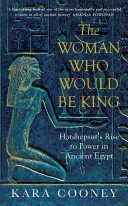
Hatshepsut, the daughter of a general who had usurped the throne of Egypt, was born into a privileged position within the royal household. Married off to her own brother, she was expected to bear sons who would legitimize the reign of her father’s family. But she failed to produce a male heir. Such was the twist of fate that paved the way for her own scarcely believable rule: she ascended to the throne as a ‘king’. Over a spectacular twenty-two-year reign, Hatshepsut proved herself a master strategist, cloaking her political power plays with a veil of piety and sexual reinvention. Just as women today face obstacles from a society that equates authority with masculinity, Hatshepsut had to operate the levers of a patriarchal system to emerge as Egypt’s second female pharaoh. Scholars have long speculated as to why her images were violently destroyed within a few decades of her death, all but erasing evidence of her rule. Constructing a rich narrative history using the sources that remain, noted Egyptologist Kara Cooney offers a remarkable interpretation of how Hatshepsut rapidly but methodically consolidated power—and why she fell from public favour just as quickly. The Woman Who Would Be King traces the unconventional life of a female pharaoh and explores our complicated reactions to women in power.